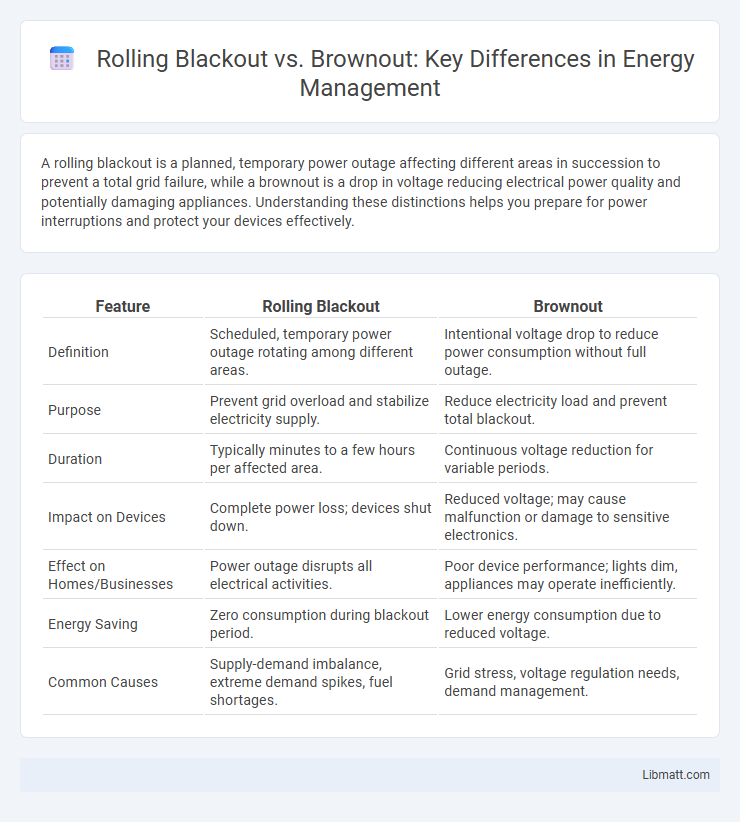A rolling blackout is a planned, temporary power outage affecting different areas in succession to prevent a total grid failure, while a brownout is a drop in voltage reducing electrical power quality and potentially damaging appliances. Understanding these distinctions helps you prepare for power interruptions and protect your devices effectively.
Table of Comparison
| Feature | Rolling Blackout | Brownout |
|---|---|---|
| Definition | Scheduled, temporary power outage rotating among different areas. | Intentional voltage drop to reduce power consumption without full outage. |
| Purpose | Prevent grid overload and stabilize electricity supply. | Reduce electricity load and prevent total blackout. |
| Duration | Typically minutes to a few hours per affected area. | Continuous voltage reduction for variable periods. |
| Impact on Devices | Complete power loss; devices shut down. | Reduced voltage; may cause malfunction or damage to sensitive electronics. |
| Effect on Homes/Businesses | Power outage disrupts all electrical activities. | Poor device performance; lights dim, appliances may operate inefficiently. |
| Energy Saving | Zero consumption during blackout period. | Lower energy consumption due to reduced voltage. |
| Common Causes | Supply-demand imbalance, extreme demand spikes, fuel shortages. | Grid stress, voltage regulation needs, demand management. |
Understanding Rolling Blackouts
Rolling blackouts refer to planned, temporary power outages implemented by utility companies to prevent a total grid failure during periods of high electricity demand or supply shortfalls. These controlled interruptions typically affect specific areas in rotation, lasting from a few minutes to several hours, ensuring balanced distribution of limited power resources. Understanding rolling blackouts involves recognizing their role in maintaining grid stability and avoiding prolonged or widespread outages.
What is a Brownout?
A brownout is a deliberate drop in voltage in an electrical power supply system, designed to reduce load and prevent a complete blackout. Unlike rolling blackouts, which completely cut power to specific areas intermittently, brownouts maintain partial power but at a lower voltage level, often causing lights to dim and some devices to operate inefficiently. This controlled voltage reduction helps stabilize the grid during peak demand or emergencies, minimizing damage to electrical infrastructure.
Key Differences Between Rolling Blackouts and Brownouts
Rolling blackouts involve planned, temporary power outages affecting an entire area to prevent grid overload, while brownouts are voltage drops causing dimmed lights and reduced electrical performance. Rolling blackouts are usually scheduled and communicated to minimize disruption, whereas brownouts occur spontaneously due to excessive demand or equipment issues. Understanding these key differences helps you better prepare for power supply interruptions and protect your electronic devices.
Causes of Rolling Blackouts
Rolling blackouts occur due to insufficient electricity supply caused by high demand, generation failures, or transmission limitations. Natural disasters, equipment malfunctions, and fuel supply disruptions commonly trigger these power cuts. Understanding your region's grid vulnerabilities can help anticipate and prepare for possible rolling blackouts.
Common Triggers for Brownouts
Brownouts typically occur due to high electricity demand during peak usage or when utility companies intentionally reduce voltage to prevent a total blackout. Common triggers include extreme weather conditions, overloaded electrical grids, and equipment failures within power plants or distribution networks. These controlled voltage reductions help maintain grid stability while minimizing the risk of widespread power outages.
Impacts on Businesses and Households
Rolling blackouts cause complete power outages for set periods, severely disrupting business operations and household activities that rely on electricity, often leading to lost productivity and spoilage of perishable goods. Brownouts, which involve a drop in voltage rather than a total loss of power, can damage sensitive electronic equipment and reduce the efficiency of appliances, increasing operational costs for businesses and inconveniencing households. Understanding the differences helps you prepare effective contingency plans to minimize financial losses and maintain safety during power supply issues.
Safety Measures During Power Interruptions
During rolling blackouts and brownouts, prioritizing safety measures is essential to protect your appliances and personal well-being. Use surge protectors to prevent damage from voltage fluctuations during brownouts, and keep flashlights and backup batteries accessible for rolling blackouts. Unplug sensitive electronics to avoid electrical shocks or fires caused by unstable power supply interruptions.
How Utilities Manage Power Shortages
Utilities manage power shortages by implementing rolling blackouts or brownouts to balance electricity supply and demand. Rolling blackouts involve temporarily shutting off power to different areas in rotation to prevent grid collapse, while brownouts reduce voltage levels to reduce load without complete outages. Understanding these strategies helps you anticipate power disruptions and plan accordingly during energy shortages.
Preventive Strategies for Blackouts and Brownouts
Rolling blackouts can be prevented by implementing demand response programs and upgrading grid infrastructure to balance electricity supply and demand effectively. Brownouts require maintaining voltage regulation through advanced voltage control devices and continuous monitoring of power quality. You can reduce risks by investing in energy-efficient appliances and backup power systems to manage inconsistencies in electrical service.
Future Solutions for Grid Reliability
Rolling blackouts and brownouts both highlight vulnerabilities in current power grid systems, emphasizing the need for advanced, resilient infrastructure to prevent widespread outages. Future solutions for grid reliability focus on integrating smart grid technology, energy storage systems, and renewable energy sources to balance supply and demand dynamically. Your ability to maintain consistent power depends on these innovations that enhance grid flexibility and real-time monitoring.
Rolling Blackout vs Brownout Infographic

 libmatt.com
libmatt.com